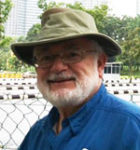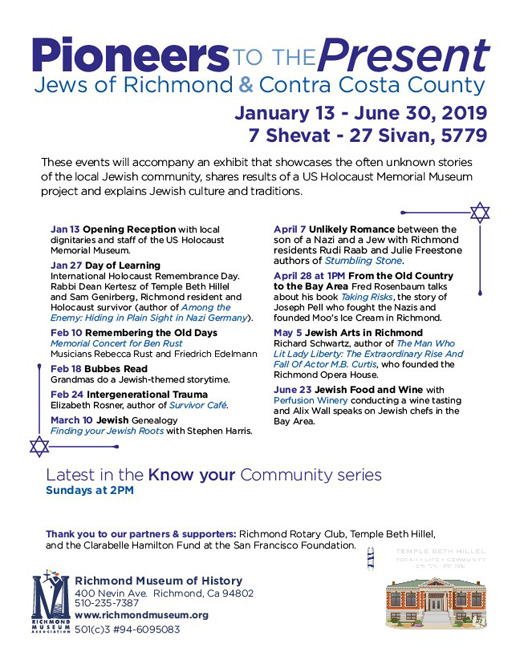By Oliver B. Pollak

RICHMOND, California — I contacted the Richmond Museum of History in March 2017 based on a story in the J – The Jewish News of Northern California seeking volunteers for a joint venture with the U.S. Holocaust Memorial Museum, “History Unfolded: U.S. Newspapers and the Holocaust,” designed to reveal what local newspapers were reporting about Germany and the Jews from Hitler’s rise to power in 1933 to the end of the war in 1945. The project identified 16,957 news reports. I offered my services, one thing led to another, and within a few weeks the museum embarked on preparing an exhibit that will run to June 30, 2019. However, the exhibit did not focus exclusively on Holocaust news coverage. Instead it was a history of the Jews of Richmond and the rest of Contra Costa County.
A committee was formed comprising a journalist, publicist, librarian, architect, museum designer, archivist, two lawyers, dramatist, and historian. Seven Jewish members were Shana Bagley, Julie Freestone, Michelle Jenkins, Ellen Pechman, Oliver B. Pollak, Carol Reif and Erin Sabari. They met frequently with the museum director Melinda McCrary and librarian-archivist Michelle Jenkins, to discuss the fundamentals of naming the project, fund raising (the ask), mission, goal, geographical reach, identifying the audience, and designing thoughtful series of Sunday afternoon programs. The museum is a nonprofit housed in the former Richmond Carnegie Library built in 1910 which became a museum in 1954.
Retired rabbis, shipyard workers, business owners, and other old timers were interviewed. The museum archives were searched for Jewish related artifacts. The City Directory was pored over.
_____________________________
See Exhibition Program below
_____________________________
Shaping the exhibit started and went through phases of contraction, just like many writing projects. Not all the ideas came to fruition. Think big but be practical and meet deadlines. A proposal to display ritual artifacts, candle sticks, kiddish cup, spice box, seder plate, menorah, mezuzah and other articles of Jewish tradition did not materialize — photographs were substituted.
Although Jews were in the county from the early 1850s, it was in Richmond during the 1940s that formal communal Jewish institutions were formed; first the Richmond Jewish Community Center, Hadassah, B’nai B’rith, Temple Beth Hillel, and most recently a Chabad house.
There are 44 panels in the exhibit, which opened on Sunday, Jan. 13 . Eleven covered the fundamentals of Judaism for a non-Jewish audience, twenty-six are concerned with Richmond Jewry and five touched on Jewish activities in wider Contra Costa County, outside Richmond, where the majority of the Jews live. The county has six Reform Temples, one Conservative congregation, six Chabad Houses, one Jewish Day School, a cultural umbrella organization, Under One Tent, and three cemeteries, spread out in Brentwood, Briones, Lafayette, Richmond, and Walnut Creek.
From 1850 to 1944 Jews in Contra Costa County were over 804 square miles. But no formal Jewish community organizations, temples, synagogues, Hadassah, or B’nai B’rith, were formed until the 1940s. Jews gravitated to the Masons. Jewish birth, marriage, and burial needs were met by travelling to Oakland or San Francisco, or by visiting rabbis.
Museum Director Melinda McCrary opened the exhibit thanking the volunteers, funders and guests. Richmond Mayor Tom Butts welcomed the approximately 200 guests, the largest ever for any prior museum exhibition. One dignitary was absent, a representative from the US Holocaust Museum in Washington DC could not attend because of the Government Shutdown. Three Temple Beth Hillel rabbis, Bernard Robinson, Judy Shanks, Dean Kertesz, and Cantor Fran Burgess led the guests in prayer and song. In late January the Museum will host a meeting of the Commission for the Preservation of Pioneer Jewish Cemeteries and Landmarks in the West.
This exhibit of Jewish life in Richmond and Contra Costa County occurred coincidentally a few days following the opening of the new commuter ferry linking Richmond to San Francisco’s Embarcadero, reviving a transport connection in the Bay Area that was abandoned over 60 years ago.

*
Pollak, a professor emeritus of history at the University of Nebraska Omaha, and a lawyer, is a correspondent now based in Richmond, California. He may be contacted via oliver.pollak@sdjewishworld.com
Pingback: History of Contra Costa County Jews on exhibit | B'nai B'rith Budapest Páholy